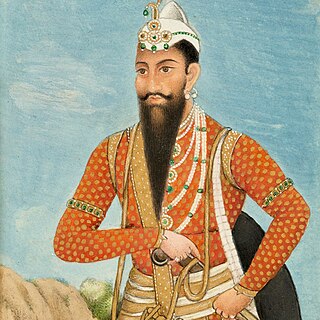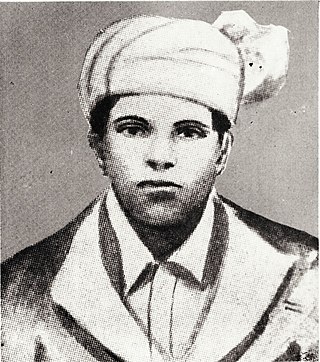
The Koh-i-Noor, also spelled Koh-e-Noor, Kohinoor and Koh-i-Nur, is one of the largest cut diamonds in the world, weighing 105.6 carats (21.12 g). It is part of the Crown Jewels of the United Kingdom. The diamond is currently set in the Crown of Queen Elizabeth The Queen Mother.
Embalming is the art and science of preserving human remains by treating them to forestall decomposition. This is usually done to make the deceased suitable for viewing as part of the funeral ceremony or keep them preserved for medical purposes in an anatomical laboratory. The three goals of embalming are sanitization, presentation, and preservation, with restoration being an important additional factor in some instances. Performed successfully, embalming can help preserve the body for many years. Embalming has a very long and cross-cultural history, with many cultures giving the embalming processes religious meaning.
The Treaty of Amritsar, executed by the British East India Company and Raja Gulab Singh of Jammu after the First Anglo-Sikh War, established the princely state of Jammu and Kashmir under the suzerainty of the British Indian Empire.

Ramtanu Pandey, popularly referred to as Mian Tansen, or Sangeet Samrat, was a Hindustani classical musician. Born into a Hindu Gaur Brahmin family, he learnt and perfected his art in the northwest region of modern Madhya Pradesh. He began his career and spent most of his adult life in the court and patronage of the Hindu king of Rewa, Raja Ramchandra Singh, where Tansen's musical abilities and studies gained widespread fame. This reputation brought him to the attention of the Mughal Emperor Akbar, who sent messengers to Raja Ramchandra Singh, requesting Tansen to join the musicians at the Mughal court. Tansen did not want to go, but Raja Ramchandra Singh encouraged him to gain a wider audience and sent him along with gifts for Akbar. In 1562, at about the age of 60, the Vaishnava musician Tansen joined Akbar's court, and his performances became the subject of many court historians.

Maharaja Sir Duleep Singh, GCSI, or Sir Dalip Singh, and later in life nicknamed the "Black Prince of Perthshire", was the last Maharaja of the Sikh Empire. He was Maharaja Ranjit Singh's youngest son, the only child of Maharani Jind Kaur.

After Abraham Lincoln was assassinated on April 14, 1865, a three-week series of events was held to mourn the death and memorialize the life of the 16th president of the United States. Funeral services, a procession, and a lying in state were first held in Washington, D.C., then a funeral train transported Lincoln's remains 1,654 miles (2,662 km) through seven states for burial in Springfield, Illinois. Never exceeding 20 mph, the train made several stops in principal cities and state capitals for processions, orations, and additional lyings in state. Many Americans viewed the train along the route and participated in associated ceremonies.

The association of Armenians with India and the presence of Armenians in India are very old, and there has been a mutual economic and cultural association of Armenians with India.

The Sikh Empire was a regional power based in the Punjab region of the Indian subcontinent. It existed from 1799, when Maharaja Ranjit Singh captured Lahore, to 1849, when it was defeated and conquered by the British East India Company in the Second Anglo-Sikh War. It was forged on the foundations of the Khalsa from a collection of autonomous misls. At its peak in the 19th century, the empire extended from Gilgit and Tibet in the north to the deserts of Sindh in the south and from the Khyber Pass in the west to the Sutlej in the east as far as Oudh. It was divided into four provinces: Lahore, which became the Sikh capital; Multan; Peshawar; and Kashmir from 1799 to 1849. Religiously diverse, with an estimated population of 4.5 million in 1831, it was the last major region of the Indian subcontinent to be annexed by the British Empire.

Premature burial, also known as live burial, burial alive, or vivisepulture, means to be buried while still alive.

Major-General Claude Martin was a French army officer who served in the French and later British East India companies in colonial India. Martin rose to the rank of major-general in the British East India Company's Bengal Army. Martin was born in Lyon, France, into a humble background, and was a self-made man who left a substantial lasting legacy in the form of his writings, buildings and the educational institutions he founded posthumously. There are now ten schools named after him, two in Lucknow, two in Calcutta and six in Lyon. The small village of Martin Purwa in India was also named after him.

Maharaja Gulab Singh Jamwal (1792–1857) was the founder of Dogra dynasty and the first Maharaja of the princely state of Jammu and Kashmir, which was a part of Panjab and Sikh Empire became the largest princely state under the British Raj, which was created after the defeat of the Sikh Empire in the First Anglo-Sikh War. During the war, Gulab Singh would later side with the British and end up becoming the Prime Minister of Sikh Empire. The Treaty of Amritsar (1846) formalised the transfer of all the lands in Kashmir that were ceded to them by the Sikhs by the Treaty of Lahore.
The Treaty of Lahore of 9 March 1846 was a peace-treaty marking the end of the First Anglo-Sikh War. The treaty was concluded, for the British, by the Governor-General Sir Henry Hardinge and two officers of the East India Company and, for the Sikhs, by the seven-year-old Maharaja Duleep Singh and seven members of Hazara, the territory to the south of the river Sutlej and the forts and territory in the Jalandhar Doab between the rivers Sutlej and Beas. In addition, controls were placed on the size of the Lahore army and thirty-six field guns were confiscated. The control of the rivers Sutlej and Beas and part of the Indus passed to the British, with the Provision that this was not to interfere with the passage of passenger boats owned by the Lahore Government. Also, provision was made for the separate sale of all the hilly regions between River Beas and Indus, including Kashmir, by the East India Company at a later date to Gulab Singh, the Raja of Jammu.
Henry Lawrence's "Young Men", also known as "the Paladins of the Punjaub", were a group of East India Company officers sent to act as "advisers" to the Sikhs after the First Sikh War in 1846. In the words of George Lawrence, his duties were "to act as a friendly adviser to the native officials". They served under the command of Sir Henry Lawrence, initially the Agent to the Governor General and later also the Resident at Lahore.
Colonel Sir Claude Martine Wade CB was a British soldier who was Agent to the Governor-General for the Affairs of the Punjab and North-West Frontier, 1823–1840. He managed relations between the British and important rulers in India such as Maharaja Ranjit Singh and Shah Shuja, King of Afghanistan. He was one of the first to "force the Khyber pass."
Sarabjit Singh Attwal was an Indian national convicted of terrorism and spying by a Pakistani court. He was tried and convicted by the Supreme Court of Pakistan for a series of bomb attacks in Lahore and Faisalabad that killed 14 bystanders in 1990. However, according to India, Sarabjit was a farmer who strayed into Pakistan from his village located on the border, three months after the bombings.

Ishaq Bux was an Indian actor.

Kharak Singh was the second Maharaja of the Sikh Empire. He was the eldest son of Maharaja Ranjit Singh, founder of the Sikh Empire and his consort, Maharani Datar Kaur. He succeeded his father on 27 June 1839 and reigned until his dethronement and imprisonment on 8 October 1839. He was succeeded by his only son Nau Nihal Singh.
Lieutenant colonel Frederick MackesonCB was an East India Company officer operating in the North West Frontier of British India and one of Henry Lawrence's "Young Men".

Hari Kishan Talwar was an Indian revolutionary from North-West Frontier Province. He is known mainly for his attempt to assassinate the Governor of Punjab, Sir Geoffrey de Montmorency. He was a young disciple of Bhagat Singh. He was hanged on 9 June 1931 in Mianwali Jail.
A burial artist is a person who intentionally endures premature burial by being voluntarily buried for extended periods as a form of human endurance contests, endurance art, escapology, or magic (illusion).












